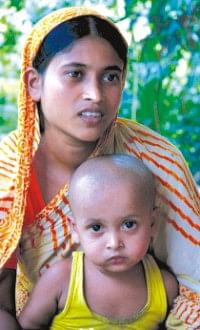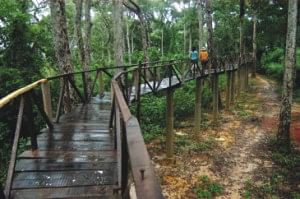Letters
Looking Forward
The January 7, 2011 issue of the Star makes for interesting reading from a number of perspectives. Ahmede Hussain (The Great Leap Forward) has been courageous in saying what others have so far been unable (or unwilling) to about the two largest political parties. I would request him to probe further and get the party-insiders, especially the grass-root members to come out with their idea of how to fix the problem.
Aantaki Raisa may be frustrated but to suggest that 2.5G is medieval is ridiculous. How many countries have the 4G technology or for that matter 3G in mobile telephony?
But what really caught the eye was the almost diametrically opposite views of Aly Zaker (One off) and Aasha Mehreen Amin (Vision for the Next Generation). According to Mr Zaker "our villages are beaming with signs of affluence" while Ms Amin suggests." Barren villages, where green fields have tuned into brick kilns and farmers have lost their land bit by bit to land grabbers, river erosion or just plain poverty..." Now which description are we supposed to accept?
Mahmudur Rahman
Gulshan, Dhaka
Awareness for the pregnant mother and her future child
 |
Photo: Zahedul I Khan |
It is obviously true that in our country at present women are playing vital roles in decision making, in the field of economy, education, etc. These days women are more conscious about equal rights, human rights and so on; that's why women are more empowered these days. But it is a matter of great regret that some women are passing their lives just like they did 20/30 years ago when female empowerment was almost unheard of. In remote areas of our country some women are deprived of their basic rights and we see or hear about many pregnant mothers dying while giving birth due to lack of proper health facilities and superstitions. Nothing is done in case of an emergency where boats, trawlers or motor bikes are used for transportation in many areas of our country, instead of ambulances. Although the government is trying to provide the basic necessities like health facilities despite many limitations in our country, all such attempts are thwarted because of backward thinking and superstition. So we hope that the respected authorities, the NGO's and the electronic and print media will play a more significant role in increasing awareness among the masses for the betterment of the society.
Subrata Ray
SUST, Sylhet
Eco tourism
potential of Inani
National Park
 |
Photo: Star File |
A couple of days ago we, the students of the 8th batch of the Forestry and Environmental Science Department of SUST, visited the Inani forest to create a forest conservation and management plan. As part of our fieldwork we have tried to identify the potential ecotourism sites in Inani. Recently the government has declared the Inani forest as a national park. It is situated under the Cox's Bazaar south forest division. It comprises an area of about 20,157 acres. Total vacant areas in the Inani Forest Ranges amount to are 3,800 acres. Almost 42 percent of tropical natural forest in this area was lost in only eight years and now this loss is happening at an unprecedented rate. The area in and around Inani National Park is rich in biodiversity. According to IUCN, at present 455 species are found in the Inani forest including the Asian Elephant. The villagers living in and around the forest are not aware of the importance of wildlife. They reported that a large number of wildlife that could be seen in the recent past is no longer seen now. Various flora and fauna are now under extreme threat of extinction due to cyclonic damage, shifting cultivation, fuel wood collection, excessive human pressure, deforestation, habitat destruction, pollution, introduction of exotic species, illegal trade and destruction of the ecosystem etc. The most important cause of fuel wood extraction appears to be the brickfields on the eastern side of the range. Due to their unsustainable collection activity, many non-timber forest products (NTFPs) such as bamboo, sun grass and various building materials appear to be decreasing at an alarming rate from this forest. Although it is now in a degraded condition it has great potential for ecotourism. Ecotourism means responsible travelling to natural areas that conserves the environment and improves the well being of the local people. The Inani beach is one of the most spectacular sea beaches in Bangladesh which is very close to the world's longest sandy beach in Cox's Bazaar and it is situated within the Inani protected forest. The route to the Inani beach from Cox's Bazar is scenic and beautiful. Green hills with luxuriant tropical rain forests can be seen on the east of the road and in the west there is crystal clear water the ultimate beauty of the Bay of Bengal. Here at the same time, visitors can enjoy the natural beauty of the forest, breathe clean air, meet with indigenous people and their culture, observe wildlife and keep an eye on the charming scenery of the beach and of course get an opportunity to escape from daily life. Ecotourism is considered an innovative strategy for the conservation of natural resources especially in areas where poverty is a real challenge. About 80 percent of the people of this area are illiterate and living under the poverty line and they always feel that extraction of forest resources is their right. So in this context the two-dimensional matrix of ecotourism can help nature conservation and improve the local economy, which reduces forest dependency. Inani can be the next destination for tourists if the government takes proper steps to improve the infrastructural facilities, communication facilities and strengthen the capability of the forest department. The government needs to improve the local economy through co-management practice and provide alternative sources of income that is fully compatible with nature conservation. This can help to restore this degraded forest and ensure sustainable yield of economic and biological resources. I have faith that the government will go through with necessary steps to conserve the existing ecosystem of this natural forest and provide all sorts of facilities that help to attract tourists to visit this national park.
Sujoy Subroto
SUST, Sylhet
CORRIGENDUM
In the last issue of The Star (January 7,2011) the by-line for Sharbari Ahmed's column Writing the Wrong was mistakenly printed as Farah Ghuznavi. We sincerely regret the error. Our heartfelt apologies to both our columnists.
Submission Guideline:
Letters to the Editor, Star Diary and Write to Mita, with the writer's name and address, should be within 200 words. All articles should be within 1,200 words. A cover letter is not necessary, but every write-up should include the writer's name, phone number and email address (if any). While The Star welcomes unsolicited articles and photographs, it cannot accept the responsibility of their loss or damage. The Star does not return unsolicited articles and photos. Response time for unsolicited write-ups ranges from three weeks to two months. All articles submitted are subject to editing for reasons of space and clarity.
All materials should be sent to: The Star magazine, 64-65, Kazi Nazrul Islam Avenue, Dhaka-1215, Fax: 880-2-8125155 or emailed to: <[email protected]>
It is recommended that those submitting work for the first time to The Star take a look at a sample copy beforehand. Our website is: http://www.thedailystar.net/magazine
Copyright (R) thedailystar.net 2010
